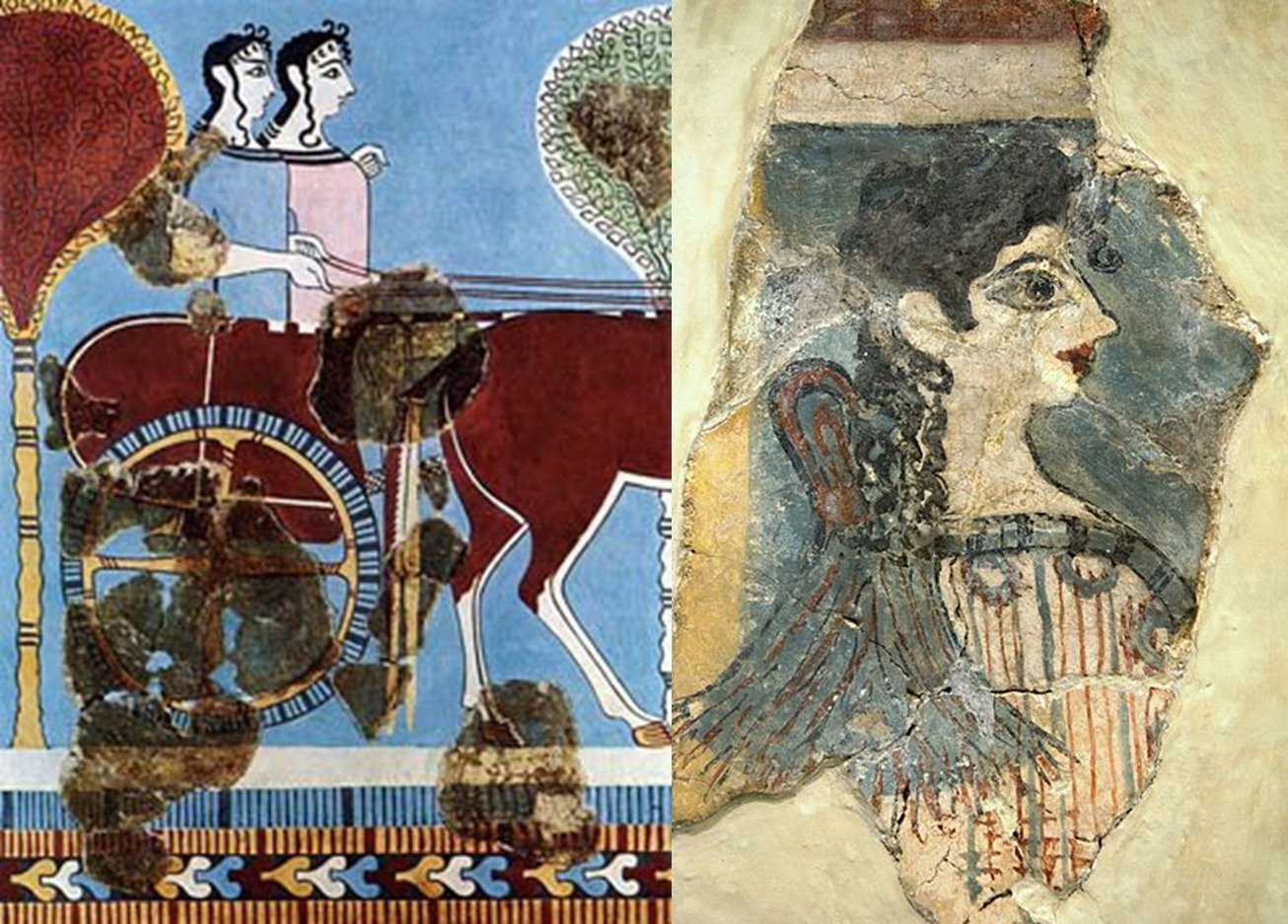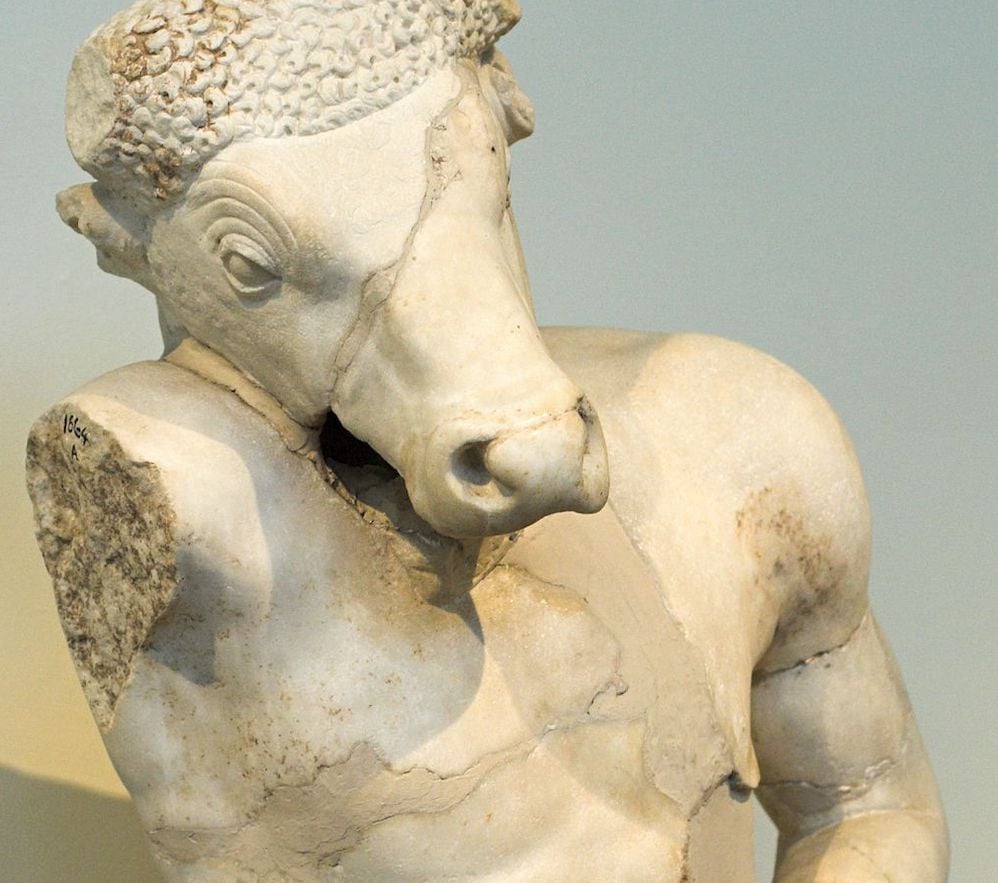
The Minoan civilization was one of the most prominent civilizations in the Bronze Age. This was also the era in which the Greeks first clearly emerged as a distinct people. Unsurprisingly, this important civilization right at the start of Greek history left its mark on the cultural memories of the Greeks. The Minoans appear various times in Greek mythology.
Who were the Minoans?
The Minoans were a people who lived in the Bronze Age in the Aegean. They thrived from approximately 2000 to 1450 BCE, although their civilization continued limping on until around 1100 BCE. Their main settlements were on Crete, but they also spread out to some nearby islands. Thera, also known as Santorini, is one notable example.
They also may have established some colonies in Anatolia and the Levant, although this is more controversial. In any case, they ruled over a major trading empire and were quite wealthy. However, in the 16th century BCE, the volcanic island of Thera erupted, wiping out the Minoan settlement in the area. In the following century, the Mycenaean Greeks conquered Crete, bringing an end to Minoan dominance.
Greek Mythology’s King Minos
One popular character from Greek mythology was King Minos. He was the king of the Minoans. In fact, the very name ‘Minoans’ was applied to this Bronze Age nation by modern historians due to the name of their legendary king.
King Minos is mentioned in various Greek sources. One early example is Thucydides, the renowned Greek historian from the fifth century BCE. He wrote:
The first person known to us by tradition as having established a navy is Minos. He made himself master of what is now called the Hellenic sea, and ruled over the Cyclades, into most of which he sent the first colonies, expelling the Carians and appointing his own sons governors; and thus did his best to put down piracy in those waters, a necessary step to secure the revenues for his own use.
It is likely that ‘Minos’ was actually a title rather than a personal name. We can conclude this based on the enormous range of time periods in which Minos appears in the Greek legends. Nonetheless, this statement from Thucydides shows that the kings of the Minoan civilization definitely made a lasting impression.
The Labyrinth and Minotaur of Greek Mythology
One of the most famous stories in Greek mythology is the story of the Minotaur. In this tale, the Greek hero Theseus is taken to the land of the Minoan King Minos on Crete. This king has an impressive labyrinth within which is a fearsome minotaur (a half-man, half-bull creature).
Minos throws Theseus into the labyrinth, obviously expecting the Minotaur to kill him. However, Theseus slays the Minotaur and escapes.
The basic idea in Greek mythology is that Minos possesses a labyrinth with a minotaur inside. This has a very plausible origin in the Minoan civilization. Consider the fact that Minos allegedly ruled from Knossos. In Knossos, archaeology has revealed the remains of an enormous palace complex. In the center, there was a large courtyard, and there is evidence that a form of bull fighting known as ‘bull leaping’ took place there.
When the Palace of Knossos was initially discovered, it was described as ‘labyrinthine,’ due to its highly complicated internal design. Additional research over the decades has confirmed such a description. It contained nothing at all like the simplicity of the Greek temples.
With this in mind, it is very likely that the legend of the Minotaur inside the labyrinth at Knossos comes from the bull fighting in the center of the labyrinthine Palace of Knossos.

Theseus overthrowing King Minos’ oppression
This story from Greek mythology of Theseus killing the Minotaur may well be related to a specific event in the history of the Minoan civilization. The reason Theseus was taken to Crete in the first place is because King Minos had imposed a regular tribute of men and women from Athens.
The Minoans would take these prisoners and feed them to the Minotaur. By killing the Minotaur, Theseus ended the oppression of King Minos over the Athenians.
While admittedly speculative, there is a reasonable theory that suggests that this comes from the historical events of the 15th century BCE. In that century, the Mycenaean Greeks defeated the Minoans and conquered Crete. This ended Minoan dominance of the Aegean.
We do not know for sure how the Mycenaean Greeks viewed the Minoans. However, legends about Minos from Greek mythology prove that the later Greeks viewed the Minoans as oppressors. Therefore, they may have remembered their historical overthrow of the Minoans as an act of freeing themselves from the oppression of a dominant power.
The Isles of the Blessed in Greek Mythology
In the fifth century BCE, the historian Hellanicus of Lesbos wrote a book called Atlantis. Although this document is now lost, a small fragment of it survives. One surviving part is the statement that ‘Poseidon mated with Celaeno, and their son Lycus was settled by his father in the Isles of the Blessed and made immortal.’
The ‘Isles of the Blessed’ appear elsewhere in Greek mythology, but the sources generally do not give them a clear, fixed location. However, there is some evidence that these islands from Greek mythology were connected to Minoan lands.
For example, there is evidence that ‘the Blessed Isle’ was one of the names for Crete. In addition, Diodorus Siculus referred to some of the Aegean islands as ‘Isles of the Blessed.’ Therefore, this story from Greek mythology about the son of Poseidon ruling over the Isles of the Blessed could well be about the territory of the Minoans.
Atlantis
One of the most famous theories about the Minoans is that they were the historical Atlanteans. In the fourth century BCE, Plato wrote about Atlantis, a rich island civilization that dominated other nations and was eventually defeated by the Greeks. The similarity to the Minoans is obvious.
Much like the Minoans, Plato describes the Atlanteans as ruling over one main island, several others, and parts of the surrounding mainland. He describes Atlantis as being a center of international trade, just like the Minoans historically were. He describes a barbaric-looking temple in which bull fighting games were held, matching the Palace of Knossos.
The description of the Atlanteans as oppressing other nations, including the Greeks, matches the idea found in Greek mythology of the Minoans being aggressive oppressors. Notably, the story of Atlantis contains the detail that the Greeks waged war against them and defeated them. This is exactly what historically happened with the Minoans.
An often-overlooked detail that confirms this theory is the fact that Plato places this war in the time of Cecrops. He also places it at about the time of the founding of Athens. From other Greek records, we know that Cecrops allegedly lived around 1500 BCE. This was also when Athens was allegedly founded.
Therefore, Plato’s information places this war with Atlantis in precisely the era in which the war against the Minoans really took place.
See all the latest news from Greece and the world at Greekreporter.com. Contact our newsroom to report an update or send your story, photos and videos. Follow GR on Google News and subscribe here to our daily email!



